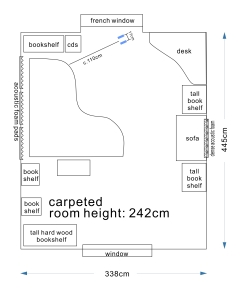Over the past years in trying to record piano at home, I’ve come to realise that although improving the room acoustics, the choice of microphones and their positioning are important factors but the most important element for successful piano recording is to have the piano serviced by a fine piano technician and keep its mechanical and tonal condition sound so that the tone can be controlled to the finest details. My piano has been fixed and serviced recently by a piano technician whom I’m very happy with. My Swedish mics seem to love this renewed piano tone as well.
Music:
Rondeau 1, with energy
from Beyond the River God
written by Graham Lynch,
performed by Yukie Smith
_________________
Recording settings:
-Piano lid fully open
-Digital recorder: Tascam DR-680
-Microphone: Line Audio CM3 (cardioid pair in A/B configuration)
-Mic position: c. 110cm off the piano pointing towards near where the curve ends
-Mic height: c.146cm
-Audio sample rate: 24bit, 48.8kHz (no EQ or reverb added)
__________________________________
My piano room layout and mics position:

________________________
Handmade acoustic panels:
6 acoustic foams are spray-glued onto a foam board, which I bought from a craft shop.

2 pieces of balsa wood (one at the top and the other at the bottom) are glued onto the board using Araldite.

The panel is fixed on the wall using 3M Damage-Free Hanging hooks (holds up to 225g).

These hook requires no drilling on the wall. Although the weight of each panel is about 1kg, I chose 225g. It’s still holding the panel up after over a year.

If you’re interested in reading the discussion on the gearslutz forum regarding how to improve piano recording at home, please follow the link below:
__________________________________________________________
My conclusion so far in my efforts in improving the room acoustics, if I need to record an album one day, I shall go to a professional recording studio.
Having said that, I’m very happy with my current audio result for what I’m using it for. I shall enjoy some more home recording for the new projects I have in mind.
